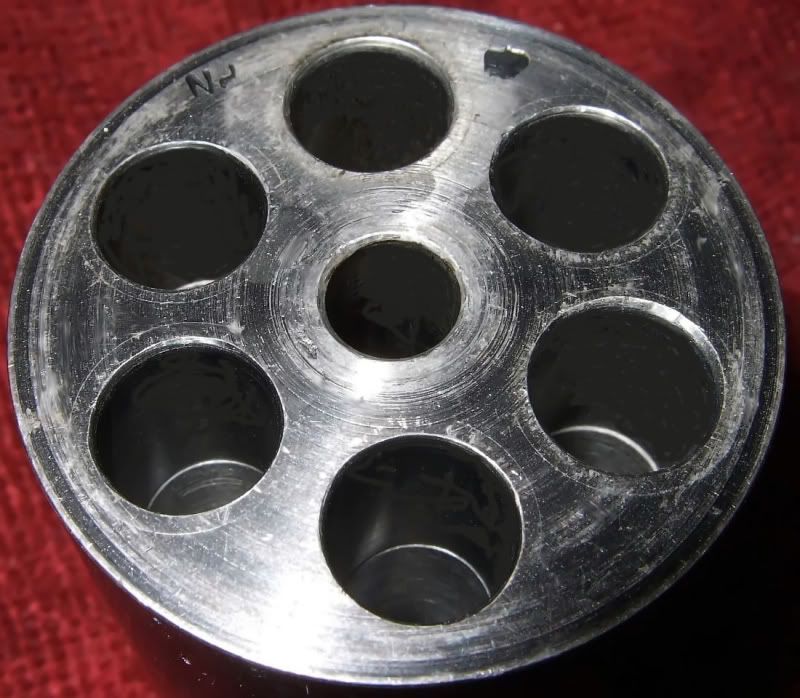Poorly Fitting Bullets:
The other major factor in chain firing deals with poorly fitting bullets. Bullets not fitting the chamber walls tightly may allow hot gases from a neighboring chamber to ignite the underlying power and again, glomming on a lot of Crisco on top of the loaded chamber does no good, you'll still get a chain fire.
Some years ago, while experimenting with a Colt replica, I made a useful discovery. The minor chain firing that still occurred after using proper loading procedures could be entirely eliminated by simply removing the sharp edges at the entrance of each chamber.
As most revolvers come from the Italian factories, the openings of the cylinder chambers are machined with sharp edges. These sharp edges bite into the soft lead of the ball as the ball is started and when the ball (or conical) is rammed down, the ball is cut leaving it undersized and unsymmetrical thus creating a gap where hot gas from another chamber can enter and ignite the charge. You can vastly improve your revolver by using a countersinking tool to remove the sharp edges at the entrances of the chambers. It is easy to do and only takes a couple of minutes. Simply hold the cylinder in you left hand and carefully grind with your right hand until the sharp edges of all six chambers are removed. When finished, your cylinder chambers will be lightly ‘chamfered’ and no more than a light chamfer is needed. This operation will not disfigure your revolver in the slightest.
Chamfered cylinder and countersink tool.
Chamfering the chambers does three things for you. First: instead of shaving off a lot of lead and ending up with an undersized, unsymmetrical ball, the ball is ‘swagged’ into the hole, thus making a perfect gas tight seal (assuming no trapped powder grains). Second: because you don’t shave off so much lead, but gently swage the ball in place, the rammer force is usually less. Third: because the ball is not undersized or unsymmetrical by having been cut, it fits the bore and engages the riflings much better. When a ball fits the bore and engages the riflings properly, you get a much more accurate shot.
Taken from : http://www.geojohn.org/BlackPowder/bps2.html
The other major factor in chain firing deals with poorly fitting bullets. Bullets not fitting the chamber walls tightly may allow hot gases from a neighboring chamber to ignite the underlying power and again, glomming on a lot of Crisco on top of the loaded chamber does no good, you'll still get a chain fire.
Some years ago, while experimenting with a Colt replica, I made a useful discovery. The minor chain firing that still occurred after using proper loading procedures could be entirely eliminated by simply removing the sharp edges at the entrance of each chamber.
As most revolvers come from the Italian factories, the openings of the cylinder chambers are machined with sharp edges. These sharp edges bite into the soft lead of the ball as the ball is started and when the ball (or conical) is rammed down, the ball is cut leaving it undersized and unsymmetrical thus creating a gap where hot gas from another chamber can enter and ignite the charge. You can vastly improve your revolver by using a countersinking tool to remove the sharp edges at the entrances of the chambers. It is easy to do and only takes a couple of minutes. Simply hold the cylinder in you left hand and carefully grind with your right hand until the sharp edges of all six chambers are removed. When finished, your cylinder chambers will be lightly ‘chamfered’ and no more than a light chamfer is needed. This operation will not disfigure your revolver in the slightest.
Chamfered cylinder and countersink tool.
Chamfering the chambers does three things for you. First: instead of shaving off a lot of lead and ending up with an undersized, unsymmetrical ball, the ball is ‘swagged’ into the hole, thus making a perfect gas tight seal (assuming no trapped powder grains). Second: because you don’t shave off so much lead, but gently swage the ball in place, the rammer force is usually less. Third: because the ball is not undersized or unsymmetrical by having been cut, it fits the bore and engages the riflings much better. When a ball fits the bore and engages the riflings properly, you get a much more accurate shot.
Taken from : http://www.geojohn.org/BlackPowder/bps2.html
Last edited:


